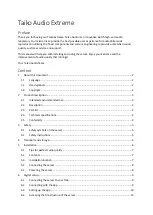
To order parts and supplies: 800.343.9353 >> eastwood.com
5
READ INSTRUCTIONS
• Thoroughly read and understand this manual before using.
• Save for future reference.
PINCH HAZARD!
• This tool has leveraged rotating components that generate greatly amplified crushing and bending forces which can quickly cause
severe injury! Keep fingers and hands away from moving parts when operating.
CUT HAZARD!
• Handling sharp metal can cause serious cuts. Wear thick, well-fitting work gloves to prevent cuts from handling sharp metal.
FALL HAZARD!
• Strenuous physical force may need to be applied to the Tubing Bender during use. Failure to ensure proper footing can quickly result i
n a fall which could inflict serious personal injury or property damage. Always work in a clean, uncluttered environment.
INJURY HAZARD!
• Be sure there is sufficient working room around the tool to allow for safe handling of various lengths of tubing.
• Excessive resistance while operating could indicate a defect with the workpiece material or broken or damaged Tubing Bender
components. To avoid injury, stop work immediately and inspect workpiece material for nicks, dents, welds, excessive scale or
remaining coatings. Clean or repair as necessary or discard and begin with a new piece. Also inspect Tubing Bender components
for looseness or damage.
ASSEMBLY
CASTER ATTACHMENT
Note that there are two Swivel Casters
[B]
and two Fixed Casters
[C]
. The two Swivel
Casters
[B]
must be attached to the same end of the Frame for proper mobility. Mount-
ing both Swivel Casters under the Front angled frame members is recommended.
• Raise and firmly support the frame of the Tubing Bender, align the flanges of
the two Swivel Casters
[B]
under the Front of the frame and, using a 13mm
wrench (not included), M8 Bolts
[E]
and Lock washers
[F]
, securely attach
them
(FIGS 1 & 2)
.
• With the Frame still supported, mount the two Fixed Casters
[C]
to the Rear
of the frame
(Fig 3)
.
FIG. 1
FIG. 2
FIG. 3
✓
B
✓
C






























